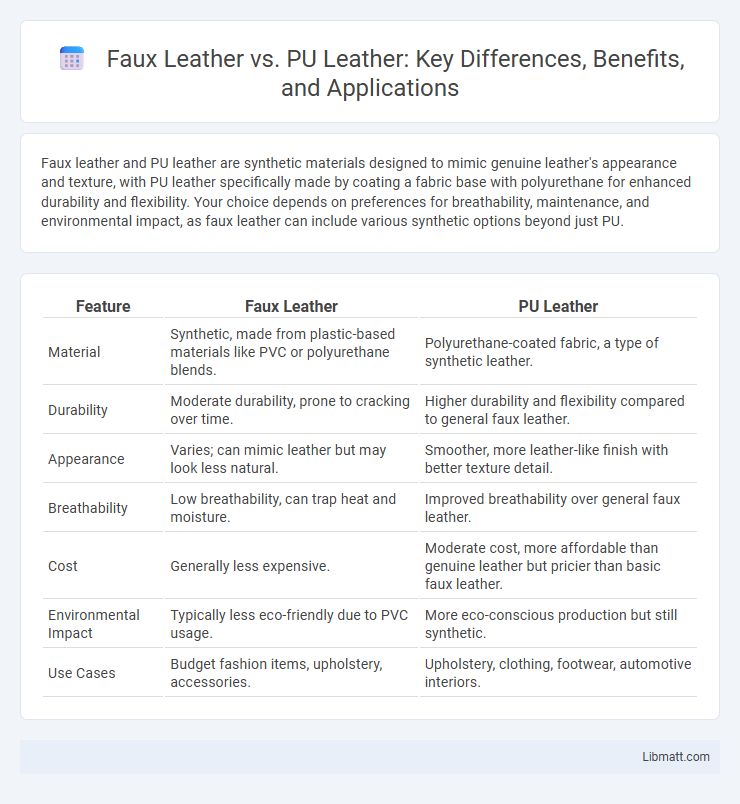Faux leather and PU leather are synthetic materials designed to mimic genuine leather's appearance and texture, with PU leather specifically made by coating a fabric base with polyurethane for enhanced durability and flexibility. Your choice depends on preferences for breathability, maintenance, and environmental impact, as faux leather can include various synthetic options beyond just PU.
Table of Comparison
| Feature | Faux Leather | PU Leather |
|---|---|---|
| Material | Synthetic, made from plastic-based materials like PVC or polyurethane blends. | Polyurethane-coated fabric, a type of synthetic leather. |
| Durability | Moderate durability, prone to cracking over time. | Higher durability and flexibility compared to general faux leather. |
| Appearance | Varies; can mimic leather but may look less natural. | Smoother, more leather-like finish with better texture detail. |
| Breathability | Low breathability, can trap heat and moisture. | Improved breathability over general faux leather. |
| Cost | Generally less expensive. | Moderate cost, more affordable than genuine leather but pricier than basic faux leather. |
| Environmental Impact | Typically less eco-friendly due to PVC usage. | More eco-conscious production but still synthetic. |
| Use Cases | Budget fashion items, upholstery, accessories. | Upholstery, clothing, footwear, automotive interiors. |
Introduction to Faux Leather and PU Leather
Faux leather and PU leather are popular synthetic alternatives to genuine leather, designed to mimic its appearance and texture. Faux leather is a broad category that includes various man-made materials like PVC and PU, while PU leather specifically refers to polyurethane-based leather. PU leather offers enhanced flexibility, breathability, and durability compared to traditional PVC faux leather, making it a preferred choice in fashion and upholstery.
What is Faux Leather?
Faux leather is a synthetic material designed to replicate the texture and appearance of genuine leather, commonly made from polyurethane (PU) or polyvinyl chloride (PVC). It offers a cruelty-free alternative with enhanced durability, water resistance, and ease of maintenance compared to real leather. The production process involves using a fabric base coated with layers of PU or PVC, resulting in a versatile and cost-effective leather substitute widely used in fashion, upholstery, and automotive industries.
What is PU Leather?
PU leather, short for polyurethane leather, is a type of synthetic leather made by coating a fabric base with a flexible polymer layer, offering a durable and water-resistant finish. It mimics the texture and appearance of genuine leather while being more affordable and easier to maintain, making it a popular choice for furniture, clothing, and accessories. Your decision between faux leather and PU leather should consider PU leather's superior breathability and stretch compared to other synthetic leather varieties.
Key Differences Between Faux Leather and PU Leather
Faux leather is a broad category encompassing all synthetic leather alternatives, while PU leather specifically refers to polyurethane-based materials within this category. PU leather typically offers higher durability, better breathability, and a more natural feel compared to other faux leather types like PVC leather. Key differences include material composition, texture, environmental impact, and price, with PU leather generally being softer and environmentally friendlier than vinyl-based faux leather.
Durability Comparison: Faux vs PU Leather
PU leather generally offers greater durability compared to faux leather due to its thicker polyurethane coating, which enhances resistance to wear and tear. Faux leather, often made from a variety of synthetic materials, tends to be less resilient and may crack or peel more quickly under regular use. Both materials are water-resistant, but PU leather maintains its appearance longer in high-friction applications like upholstery and fashion accessories.
Appearance and Texture Differences
Faux leather often has a more consistent and uniform appearance with a slightly matte finish, while PU leather tends to exhibit a smoother surface and a glossier sheen, mimicking genuine leather more closely. You will notice that faux leather textures can feel stiffer and less supple compared to the softer, more flexible texture of PU leather. These differences in appearance and texture impact both the look and feel, making PU leather a popular choice for products seeking a more authentic leather experience.
Cost Analysis: Faux Leather vs PU Leather
Faux leather typically costs less than PU leather due to lower manufacturing expenses and simpler material composition. PU leather, made by coating fabric with polyurethane, offers enhanced durability and appearance at a higher price point, reflecting its improved quality. Understanding these cost differences helps you make an informed choice balancing budget constraints and material performance.
Environmental Impact and Sustainability
Faux leather, typically made from non-renewable petroleum-based materials, has a higher environmental footprint due to its energy-intensive production and limited biodegradability compared to PU leather, which often incorporates water-based coatings and more sustainable manufacturing practices. PU leather's eco-friendly variants reduce harmful chemical emissions and promote recyclability, making it a preferable choice for sustainability-conscious consumers. Your decision between faux and PU leather impacts resource consumption and waste generation, highlighting the importance of selecting materials aligned with environmental responsibility.
Maintenance and Care Tips
Faux leather requires regular dusting and gentle cleaning with a damp cloth to maintain its appearance, while PU leather benefits from occasional conditioning with a specialized leather conditioner to prevent cracking. Both materials should be kept away from direct sunlight and heat sources to avoid fading and deformation. You can extend the lifespan of your leather items by storing them properly and promptly addressing any spills or stains.
Which is Better: Faux Leather or PU Leather?
Faux leather is a broad category that includes various synthetic leathers, with PU leather being a specific type made from polyurethane, offering a softer and more flexible texture. PU leather generally outperforms other faux leather types in durability, water resistance, and ease of cleaning, making it a preferred choice for upholstery, fashion, and accessories. Your decision depends on the intended use and budget, but PU leather is often considered better for combining quality and affordability within synthetic leather options.
Faux leather vs PU leather Infographic

 libmatt.com
libmatt.com